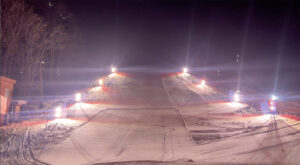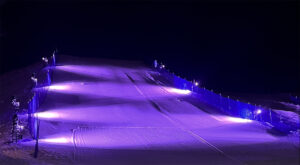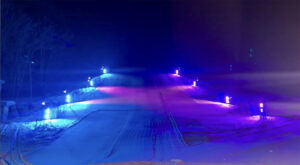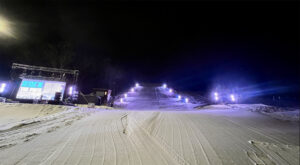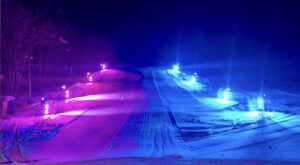Crowds congregate annually at the base of ‘Smart Alex’ ski trail in Ontario to watch the state’s finest freestyle skiers and snowboarders perform choreographed flips and tricks off the 50ft Big Air Jump, accompanied by music, lights, fireworks and all manner of show sizzle.
To provide this for the ‘The Big Air Show’, as the event is known, required the building of a technical infrastructure, with towers rigged with 24 of GLP’s ultra-versatile JDC1 hybrid strobes so that spectators could track the action coming down the 200ft slope and onto the landing ramp. The FOH position itself was set 50ft back, behind the video screen.
To make matters more difficult, the Air Jump takes place in the grip of a Canadian winter, which this year saw three days of snow and rain. Yet the JDC1s, despite not being IP-rated, performed flawlessly.
They had been recommended by the lighting designer Andrew Dawson, who also worked on the event last year. He teamed up with old friend (and long-term associate) Matt Chambers from PSI (Production Service Industries of St. Catherines, Ontario). They, in turn, were hired by the event’s regular main contractor Cass Audio Productions, who were again working for promoter, Blue Mountain Resort.
The GLP inventory itself was provided by Toronto-based Christie Lites, while another key figure in the event’s success was dimmer tech Antony Kahil.
After his work on the event last year Dawson had again been contracted by Cass Audio and he had no doubt that this year the JDC1 would be the fixture of choice.
“I’m the biggest fan of JDC1—it’s an absolute workhorse and features in all my designs,” he exclaimed. And it was this versatility that also appealed to Chambers, who had tight control of the purse strings.
He explained, “It’s funny, most LDs like to ask for as much as they can in the initial design phase; instead, this time when I asked Andrew what fixtures he wanted he said 24 JDC1. I was quick to agree, as I was aware of its brightness and versatility—which would be key features outdoors.” And this simple requirement also made it extremely budget friendly.
The latter was clearly well aware of its capabilities. “With the JDC1 I have a wash, a strobe and effect light all in one fixture. It was just so bright, and with so much ambient light to deal with that was essential; they certainly did their job.”
The prep was arduous, with a two-day build, followed by a rehearsal day, five nights of shows and then teardown. This was preceded by four days in pre-viz, which certainly paid dividends as Chambers explained. “I was able to free draw something prior and scale the landing; comparing the 3D model, it was very close in reality to the pre-viz.”
Four towers were placed on either side of the landing with two free-standing JDC1 in each. The remainder were rigged around the perimeter. The run itself was set at around 42° before flattening out at the landing.
Andrew Dawson programmed the fixtures in 68ch Mode 3 to get full creativity, running the show off a grandMA3. “My approach was to keep it clean and simple and high impact,” he said. “I wanted to use them as blinders, wash lights and strobes—and they held up to everything I threw at them. For pixels and general eye candy they were great, and as for side lighting, they produced an impressive wash, with excellent colour rendering which was consistent right across the colour palette. It delivered all the punch and intensity I needed.”
This brought out the carefully choreographed theatricality, manifested by each performer in a series of 40-minute shows. The intro and outro was played to time code but with each skier having a soundtrack Dawson would then go into freestyle mode, mixing on the fly as they went through their repertoire of tricks and comedy routines.
Both creatives admit they are generally more at home working in a concert arena. “But when I was asked last year if I wanted to do a show on the side of a ski hill I realised it wasn’t something we would do every day,” noted Dawson. It was fun and we certainly learnt a lot from last year that we could apply to this year. Although this made it much easier there was still a lot of calculated risk.”
Summing up, he concluded: “The event was a great success overall and I was extremely happy with the result. Thanks to its intensity, the JDC1 added so much coverage—following the skiers from the take off right down the slope to the landing.”
And Cass Audio owner, Ben Cassidy, added, “We appreciate all the hard work from our sub-contracted employees and look forward to running this event, working alongside Blue Mountain Resort, for many years to come.”

